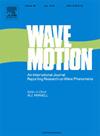耦合方程流氓波的体积
IF 2.1
3区 物理与天体物理
Q2 ACOUSTICS
引用次数: 0
摘要
流氓波可能出现在各种物理场景中,包括那些由耦合方程描述的场景。耦合方程的流氓波对的体积可以使用每个单独流氓波的强度来定义,也可以通过流氓波对的组合定义来定义。我们考虑了支持明暗流氓波对的马纳科夫方程和其他各种方程。这以一种有用的方式扩展了流氓波 "体积 "的概念,并允许使用一个数字来描述这些波对。如果可以从实验数据(例如水箱中的数据)中找到体积,那么就可以推导出内部溶液参数的值。本文章由计算机程序翻译,如有差异,请以英文原文为准。
Volumes for rogue waves of coupled equations
Rogue waves can appear in various physical scenarios, including those described by coupled equations. Volumes for rogue wave pairs of coupled equations can be defined using intensities of each individual rogue wave, or via a combined definition for the pair. We consider Manakov equations supporting bright-dark rogue wave pairs, and various other equations. This extends the rogue wave ‘volume’ concept in a useful way and allows for characterization of these pairs by using a single number. If the volume is found from experimental data, e.g. in a water tank, then the values of internal solution parameters can be deduced.
求助全文
通过发布文献求助,成功后即可免费获取论文全文。
去求助
来源期刊

Wave Motion
物理-力学
CiteScore
4.10
自引率
8.30%
发文量
118
审稿时长
3 months
期刊介绍:
Wave Motion is devoted to the cross fertilization of ideas, and to stimulating interaction between workers in various research areas in which wave propagation phenomena play a dominant role. The description and analysis of wave propagation phenomena provides a unifying thread connecting diverse areas of engineering and the physical sciences such as acoustics, optics, geophysics, seismology, electromagnetic theory, solid and fluid mechanics.
The journal publishes papers on analytical, numerical and experimental methods. Papers that address fundamentally new topics in wave phenomena or develop wave propagation methods for solving direct and inverse problems are of interest to the journal.
 求助内容:
求助内容: 应助结果提醒方式:
应助结果提醒方式:


